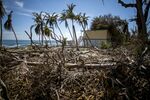Puerto Rico Governor Says Storm Deeply Cut Ability to Pay Debts
By and-
Prior plan would have paid $3.7 billion over next five years
-
Comments confirm speculation investors faced steeper losses

Puerto Rico Governor Ricardo Rossello said the government’s ability to pay even a fraction of its debts was reduced by the crippling blow of Hurricane Maria, which has caused tens of thousands of residents to leave and pushed the economy into a deep contraction.
The governor’s comments to reporters in San Juan came ahead of a revised fiscal plan that the bankrupt commonwealth is set to submit to its federal oversight board. Skipping debt payments outright would save the U.S. territory hundreds of millions of dollars a year compared with what it had been prepared to pay before the storm, freeing up cash for rebuilding and allowing it to avoid deeper budget cuts that could further impede its recovery.

Ricardo Rossello
“We had to consider the significant social impact that Maria caused, due to the massive exodus that we’ve had and are expected to have in the future,” Rossello told reporters Wednesday in San Juan.
The comments underscore the deep losses facing owners of Puerto Rico’s $74 billion of bonds, whose prices have tumbled since the Sept. 20 hurricane amid widespread expectation that even more of the government’s obligations will need to be written off in bankruptcy. The blueprint, if approved by the federal overseers, will serve as a basis for negotiations with bondholders.
The new fiscal plan comes as island officials estimate its gross national product will contract deeply in the year ending in June, officials told reporters today in San Juan. That’s expected to reverse next year with the help of federal disaster funds and rebuilding after Hurricane Maria.
The September storm, which destroyed much of the island’s electricity system, cut into tax collections and prompted many residents to flee to the U.S. mainland, exaggerating the financial drain that had already pushed it to the brink. A lawyer for the federal control board last year said in a court hearing that a five-year moratorium may be needed, given the severity of the disaster it’s facing.
While the administration believes Puerto Rico is unable to pay bondholders, the federal board will lead negotiations with creditors and the bankruptcy court will decide the ultimate payments, Rossello told reporters.
Puerto Rico began defaulting on its bonds in 2015, unable to repay what it owed after years of losing residents. It filed for bankruptcy in May after the U.S. enacted an emergency rescue law that gave it power to do so and installed the federal board to help the commonwealth’s government chart a financial turnaround.
Puerto Rico’s original recovery plan said it could allocate $8 billion for debt payments through 2026, far less than the $33.4 billion that’s owed. The government’s payments under that plan would have amounted to $3.7 billion through 2022, a period when $17.1 billion of principal and interest is set to come due.
Puerto Rico has yet to detail how any losses would be distributed among various classes of bonds backed by different legal pledges and with sometimes competing claims to the government’s cash. Groups of creditors are currently fighting over that issue in court.
Prices on most commonwealth securities have tumbled over the past two months. General obligations with an 8 percent coupon and maturing in 2035 traded Wednesday for an average of 26 cents on the dollar, down from as much as 59 cents in September, before the storm. Some bonds trade for even less, with those issued by the infrastructure and highway agencies going for pennies on the dollar.
— With assistance by Jonathan Levin